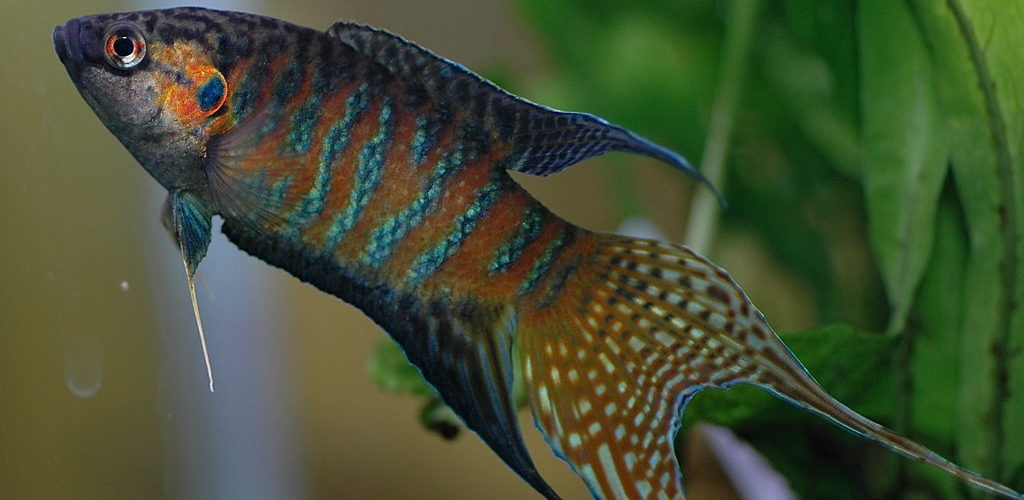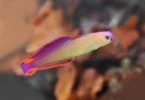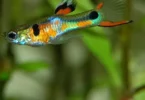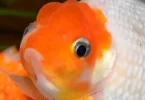Last Updated on November 19, 2022 by Matt
If you are looking to stock a freshwater aquarium, there are many options to look at, from small guppies to large angelfish. So should you look at paradise fish? They are a very striking species, which do very well in the aquarium environment due to their hardy nature and broad temperature range but they do possess aggressive behaviors.
Paradise fish are a species of gouramis which are native to rivers and streams of South-East Asia, from northern Vietnam to the Korean Peninsula. They are a stunning species of freshwater fish, known for the incredibly vivid and vibrant colors of the males. In this Paradise fish care guide we will give you a profile of this species; where they come from, their behavior, and how best to care for this eye-catching species.
Paradise Fish Summary Family Osphronemidae Care Level Moderate Minimum Tank Size 20 Gallons Temperature Range 60°F – 82°F (15.5°C – 28°C) pH 6 - 8 General Hardness 5 – 30 dGH Carbonate Hardness 5 – 20 dKH Temperament Semi-aggressive Diet Omnivorous
IN THIS ARTICLE
Paradise Fish Species Profile
Paradise fish is the common name of the species Macropodus opercularis. Members of this species are also known as paradise gouramis. They are part of the Osphronemidae family which contains all gourami species; many gourami species are commonly kept in aquariums, such as the three-spot gourami, dwarf gourami, and without doubt the best known, the Betta fish. In this section of our paradise fish care guide we will provide descriptions of the appearance, size, life span, and behavior of this exquisite fish.
Appearance
The appearance of the paradise fish is the major reason why they were one of the first ornamental fish available for western aquarists after being imported to France in 1869. Paradise fish have a vivid blue and red coloration, with the blue and red in alternating vertical stripes over the body. The fins are usually one color, with the caudal fin orange/red and the anal and dorsal fins blue/grey in coloration. The caudal fin is deeply forked with long filaments that flow behind the fish as it swims. Long flowing filaments are also found on the anal and dorsal fins. These fins are edged by white on most paradise fish, almost highlighting the fish as it graces the tank. The head is very pointed while the body is very flattened, which gives the paradise fish it’s classic gourami look.
Like the majority of gouramis, the paradise fish exhibits sexual dimorphism, with the males being larger as well as more colorful and extravagant than the females, having larger and longer caudal, dorsal, and anal fins.
Interestingly, the paradise fish is one of the few species which can actively change its coloration lighter or darker in response to stimuli. Watch your fish and see how it reacts and learn to notice its mood!
Size
Male paradise fish can reach 4 inches in length, while the females are usually a smaller 3 inches in length.
While this may not seem like a large size, given their aggressive nature they can and will eat smaller fish, especially fry. So if you are wanting to breed fish in a tank containing paradise fish it is best to get a special breeding tank where the fry can grow unhindered to a size where they will not be in danger of being lunch.
Lifespan
Paradise fish are fairly long-lived fish, with a usual lifespan of between 7-9 years. There are instances where these fish will happily exceed 10 years old. While this is their usual lifespan, this does depend on them being given the right environment to reach this age. If you do not look after your paradise fish appropriately it won’t survive long.
Appropriate conditions include diet, tank size, appropriate tank mates, suitable water parameters, and a clean tank. We will go through all of these factors later in the article and explain how to care for your paradise fish well so that it survives a long time and continues to bring color and spark to your tank.
Behavior
All species in the gourami family are somewhat aggressive and territorial fish. The paradise fish is actually one of the more aggressive species of gouramis, however is not quite as quick to fight as the combtail gourami.
Males are a lot more aggressive than the females, as they fight over territory and mates. Therefore like the betta fish, it is highly recommended to not keep more than one male in any given tank. Even in very large tanks male paradise fish will claim a large territory and fight each other for it, especially if there are females in the tank as well. The fights males have can be quite brutal, with serious damage being dealt, and fish are known to kill one another.
This aggression isn’t only limited to members of their own species; paradise fish aren’t afraid to show other fish who’s boss either. Fish which possess a very bright coloration are at risk of being on the receiving end of aggressive behavior as they are seen as competitors to the paradise fish. However fish who don’t possess bright or vivid colorations are likely to be left alone. This is why paradise fish have the label of semi-aggressive, as they aren’t aggressive to all and any fish, only conspecifics or those they deem to be direct competitors.
As we have mentioned in the appearance section, paradise fish are one of the only freshwater fish species to be able to actively and consciously change color according to mood and situation. While this color change isn’t incredibly dramatic like those of cuttlefish; these mollusks have specialized cells to create patterns and change coloration in a second; they do get noticeably lighter or darker.
Paradise fish, like all gouramis, possess a labyrinth organ which enables them to breathe air as well as water. As such they tend to dwell in the top to middle of the water column.
Paradise Fish Care
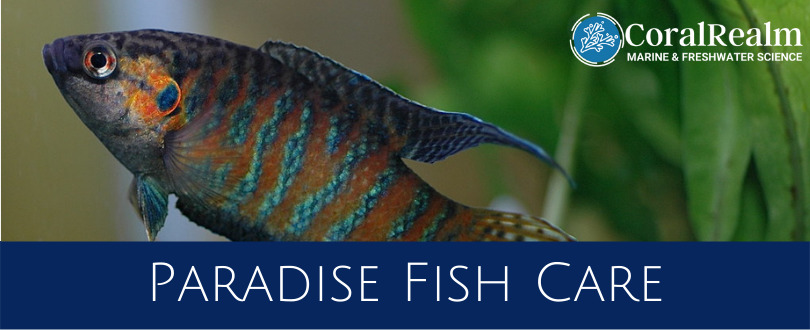
In the following section we will describe paradise fish care needs in terms of diet, tank size, and water parameters.
Diet
Paradise fish are omnivorous, which means they eat both plant-based and animal-based foods. They are quite unfussy and will happily eat most things they are fed. However this can unfortunately mean that they are often fed the incorrect diet. It’s easy to think that because they are happily eating almost anything that they are getting the nutrients they need. But they actually need a high-protein diet in order to remain healthy. High protein means lots of animal based foods, rather than usual fish food pellets which are more often than not plant based.
As in the wild paradise fish are quite prolific hunters, they need to be regularly fed live foods such as mosquito larvae, brine shrimp, and black worms.
Tank Size
For any fish species having the correct tank size is very important. If the tank is too small the fish will feel confined, be more aggressive and territorial, and may not eat properly due to increased stress. As we have already said that the paradise fish is quite an aggressive species, it is important not to house them in a tank which is too small.
A single male needs a minimum tank size of 20 gallons, while a mixed male and female tank, or community tank with one male should be a 20 gallon long aquarium or 30 gallon regular tank minimum. Do take note that these are the minimum sizes required to keep paradise fish healthy. In order for your paradise fish to be as healthy and happy as they can be it is highly recommended to have a larger tank. As paradise fish live naturally in the rivers and streams of South-East Asia, they require lots of plant life in the tank to feel comfortable. Having many different species of plant in a tank leans towards having a bigger tank, as there is more space to accommodate a variety of species.
Water Parameters
Paradise fish are very hardy and can survive in a range of water conditions. This makes them a perfect inhabitant of a wide variety of freshwater aquarium. They are one of the few tropical freshwater fish species which can survive and thrive in cold water tanks.
Paradise fish can survive in water from 60°F – 82°F (15.5°C – 28°C). The ideal is at the middle of this range, but they can thrive at any temperature in this range, and some sources even say that they can handle temperatures outside this as well. As we have said already, this large temperature range makes paradise fish one of the few species which can survive in both cold and tropical freshwater environments. Due to this hardiness only a heater, thermometer, and filter are completely necessary for maintaining paradise fish successfully. Like a betta fish filter, a paradise fish filter should have mechanical, chemical, and biological filtration to remove dirt and debris, along with ammonia, nitrite, and excess nitrate, while keeping the water circulation to a minimum. A good aquarium light such as an LED light is necessary to illuminate the tank and keep the fish and plants healthy.
Paradise fish require a neutral pH range of 6 – 8. Aiming for and trying to maintain a neutral pH of 7 will mean that if it slips to an acidic 6 of alkaline 8 that your paradise fish will still be within its limits.
In terms of water hardness, paradise fish need a general hardness of 5 – 30 dGH and a carbonate hardness of 5 – 20 dKH.
Paradise Fish Tank Mates
As they are mid-sized semi-aggressive and territorial fish, you do need to be a little careful about paradise fish tank mates. You can keep a single male paradise fish on it’s own no problem, although as the males’ colors are to attract females the coloration will be a little muted without them around. Keeping a single male with a group of females is also perfectly fine, and perhaps the best way of really showing off paradise fish. Males shouldn’t be kept together as they will fight. These fights can get intense and cause serious injury.
If you want to keep paradise fish in a community tank with other species be careful about which species you pair them with. As paradise fish are territorial and inhabit the upper portion of the water column, try and avoid colorful fish which also live in this area. If you want top dwelling fish, you want large dominant fish as paradise fish will likely take a back seat and be submissive. Paradise fish live well with bottom-dwelling fish. For instance plecos such as the bristlenose and the clown loach and kuhli loach are large enough to keep themselves out of trouble, and also inhabit the bottom of the tank where the paradise fish are unlikely to enter.
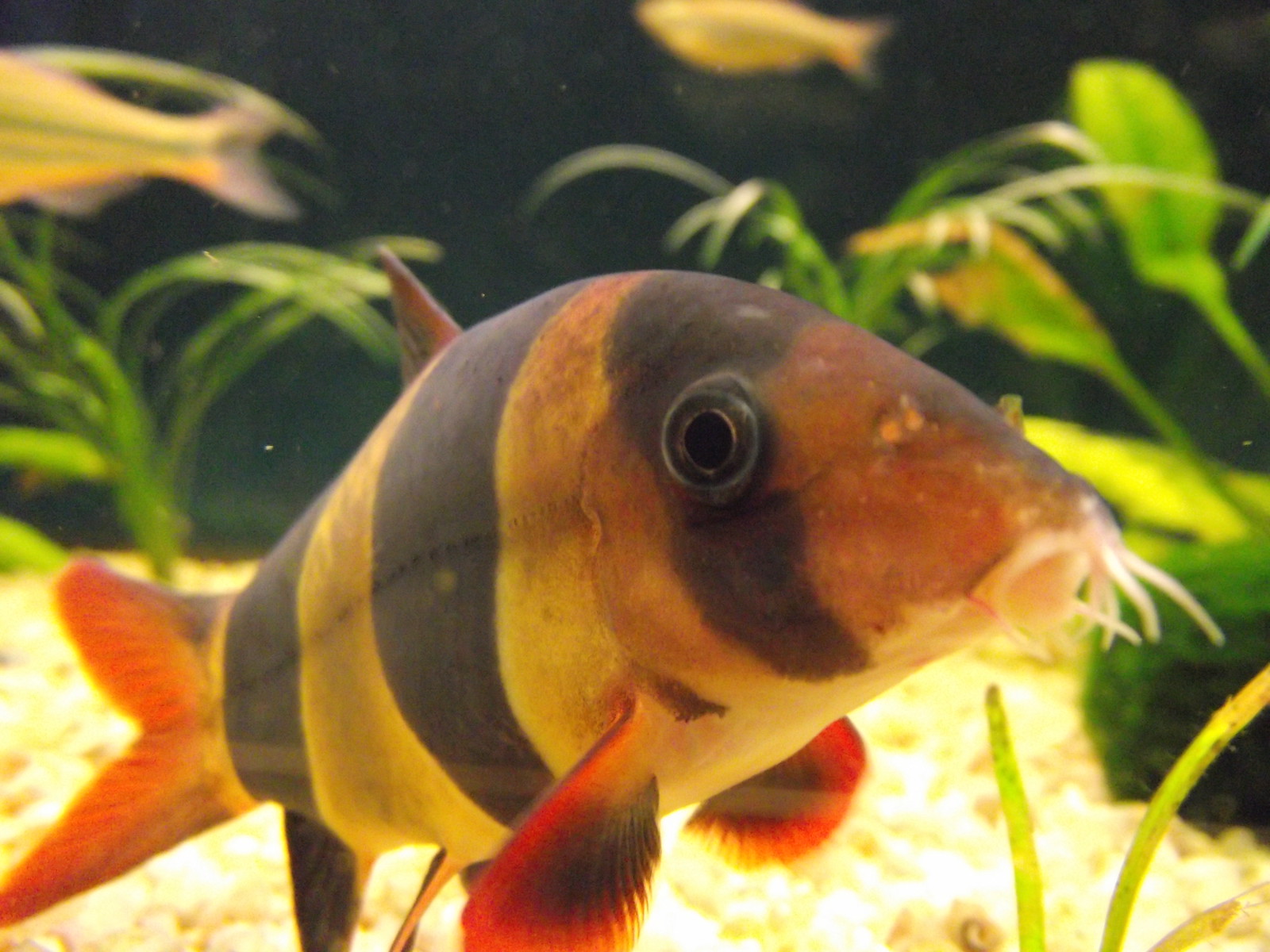
The clown loach can be a great paradise fish tank mate
Other fish which are suitable are large characins and cyprinids, which are tough enough to not be hassled by a territorial paradise fish. Also suitable are the large cichlids of the Geophagus genus. Larger gourami species can also be good tankmates for paradise fish provided there is enough space and hiding places. The pearl gourami can be a good fit.
Avoid any fish with long fins, such as freshwater angelfish, as paradise fish will nip them can cause distress.
Invertebrates such as shrimps and snails can be a bit of a 50/50 when it comes to suitability with paradise fish. It can depend on the individual fish. Some fish eat whatever invertebrates they can fit into their mouths, while others are happy to live side by side. So while it wouldn’t be recommended to buy expensive shrimp right off the bat, trying some cheap ones and seeing how they get on can be an idea. Also try feeding your paradise fish lots of live foods to distract from the tasty looking invertebrates you don’t want eaten!
Try having a look at our betta fish tank mate guide, as these two fish are quite similar so you may get some ideas.
Paradise Fish Plants
In their natural habitat paradise fish live in rivers and streams of South East Asia; these ecosystems are quite densely planted with both floating and rooted plants. Therefore most aquarium plants are absolutely fine to have with paradise fish, and help to make them feel comfortable and at home in your tank.
Most rooted plants are absolutely fine with paradise fish, but while floating aquarium plants are also a part of their natural habitat a bit more care needs to be taken with them. This is because paradise fish are a part of the gourami family, and possess a labyrinth organ which enables them to breathe air. As such they need to be able to access the surface at all times. Therefore plants like duckweed and dwarf water lettuce which are fast growing and can easily cover the surface aren’t great to pair with paradise fish but can be used if managed properly and care is taken.
As paradise fish are omnivorous and will happily eat almost anything, they will nibble at plants and so having species which can handle this is a must. A freshwater plant such as hornwort is perfect as it is fast growing and hardy, able to handle being pecked at. It is also able to be utilized as both a rooted and floating plant, so can offer great flexibility for your tank. Java moss and dwarf hairgrass are other plants well suited for a paradise fish tank. Java fern is another which can look fantastic, and has tough leaves which should deter fish nibbling them.
Paradise Fish Breeding
Like all gouramis in the Osphronemidae family, paradise fish produce bubble nests to lay their eggs. Typically the males produce these nests on the underside of broad leaves, though they can make them on the surface as well. The bubbles are surrounded with a layer of mucus which enables the bubbles to hold together and be more durable. Read our fish reproduction overview for more general information about fish breeding and reproduction.
To successfully breed paradise fish, firstly you will need to feed the female well with highly nutritious foods, as she will likely refuse to eat for around two weeks as she fills with and holds eggs. When the female is full of eggs she will appear very large and big-bellied. It’s then time to isolate the female with the breeding male in a separate breeding tank of at least 20 gallons. Don’t isolate the pair until the female is full of eggs, otherwise the male could become very aggressive towards the female. The breeding tank should have normal conditions but should have the water surface free and clear, so fry can breathe and develop the labyrinth organ normally.
Once the male has built the nest and fertilized the eggs laid by the female, immediately remove the female from the breeding tank. The male will aggressively guard the nest, even from the female, and she risks being killed if kept in the tank. The eggs tend to hatch at around 30-50 hours after fertilization, but this time can vary greatly and be as long as 100 hours. Keep the male in the breeding tank keeping guard, as he is in protective mode and will be aggressive if taken back to the main tank. While guarding the nest the male won’t eat; however, offer him food at various stages of the egg maturation process and when he begins to accept it transfer him back to the main tank. If left with the hatching eggs the male may eat the newly hatched fry.
Common Issues
The most common issue with keeping paradise fish is intraspecies aggression, namely infighting amongst males. Interspecies aggression can also be an issue, with colorful top dwelling species prone to be subject to the territorial nature of the paradise fish.
Not only does fighting directly impact the health of your fish as they can get quite severely injured, it also can impact them indirectly too through disease. When fish fight and injure each other the cuts, wounds, and abrasions are very susceptible to bacteria, fungus, and viruses.
Paradise fish are susceptible to all of the usual infections that you should look out for, such as fin rot and mouth fungus. Lymphocystis disease is a viral infection which affects paradise fish which you should know the warning signs for; typically you will see lesions and nodules on the skin and fins.
The major contributor towards both bacterial and viral infections is stress. Fish are greatly stressed by being taken from one tank into another, so introducing new fish to your tank slowly and properly is key in reducing the likelihood and susceptibility of your fish to disease. Also ensuring that your fish have a clean and natural tank will help to make them feel at home and reduce stress.
Are Paradise Fish Right For You?
While paradise fish breeding can be a little difficult as the males get very aggressive, paradise fish care in general is very easy. They are very hardy fish which can tolerate a wide range of temperatures and other conditions. The main draw in getting paradise fish is their appearance, as the males especially have long flowing fins and are very brightly colored. Top-dwelling fish, they are guaranteed to be the star of any aquarium.
The main drawback to paradise fish is their aggression. You need to be aware that they will be aggressive towards other brightly colored fish, and so care needs to be taken with paradise fish tank mates.
In general though, they are an amazing fish for most freshwater aquariums.

